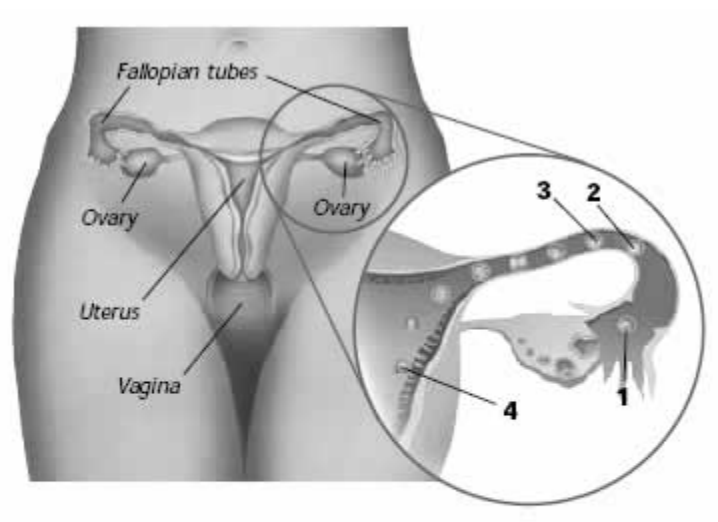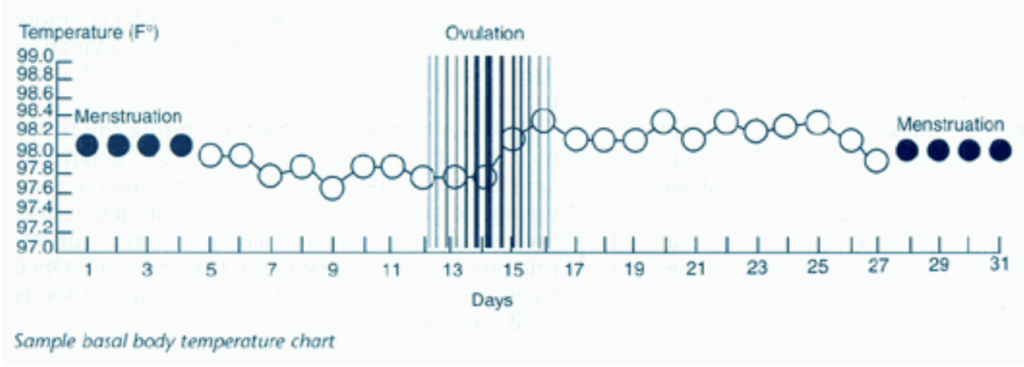Natural family planning is a form of birth control that is based on the timing of sex during a woman’s menstrual cycle. Natural family planning used to be called the rhythm method or “safe period.” It also is called periodic abstinence or, more recently, fertility awareness. It isn’t a single method but a variety of methods.
This page will explain:
- How natural family planning works
- The types of natural family planning
- How well the method prevents pregnancy
About Natural Family Planning
Natural family planning can be an effective way to prevent an unwanted pregnancy. It is safe and very low cost. The success or failure of any of these methods will depend on your ability to:
- Recognize the signs that ovulation (the release of an egg from the woman’s ovary) is about to occur
- Not have sex during the fertile period or use another method, such as condoms, during the fertile period
For this method to work, a woman needs to know her body well, and she and her partner must be willing to follow the method. This method can only work when it is followed correctly at all times. Even with perfect use, a woman has a risk of pregnancy. With natural family planning, the time during which sex is less likely to result in pregnancy is limited, and sex becomes a lot less spontaneous. Because of this, some couples may find it very hard to use this method.
Natural family planning can work only if you and your partner follow the method correctly at all times. If you do, this can be an effective way to prevent pregnancy.
Natural family planning is not as effective as most other methods of birth control. One in four women who use this method become pregnant. The method is not suited for women:
- Who should not get pregnant because of medical reasons
- With irregular periods who may not be able to tell when they are fertile.
- With abnormal bleeding, vaginitis, or cervicitis (these make the cervical mucus method unreliable)
- Who use certain medications (for instance, antibiotics, thyroid medications, and antihistamines) that may change the nature of vaginal secretions, making mucus signs impossible to read
- With certain problems unrelated to fertility (for instance, fever) that can cause changes in basal body temperature
How Natural Family Planning Works
Reproduction
To understand how natural family planning works, you should know what happens during reproduction. A woman has two ovaries, one on each side of the uterus. Each month, one of the ovaries releases an egg into a fallopian tube. This is called ovulation. It typically occurs about 12–14 days before the start of the menstrual period.
A woman can get pregnant if she has sex around the time of ovulation. During sex, the man ejaculates sperm into the vagina. The sperm travel up through the cervix and into the fallopian tubes.
If a sperm meets an egg in the fallopian tube, fertilization—union of egg and sperm—can occur. The fertilized egg then moves down the fallopian tube to the uterus. It then attaches to the uterus and grows into a fetus.

Each month during ovulation, an egg is released (1) and moves into one of the fallopian tubes (2). If a woman has sex around that time, an egg may meet a sperm in the fallopian tube, and the two may join (3). This is called fertilization. The fertilized egg then moves through the fallopian tube in the uterus (4).
Family Planning
Each method of natural family planning is designed to help a couple find out which days during a woman’s menstrual cycle she is likely to be fertile or able to become pregnant. That way, the couple knows when not to have sex to avoid a pregnancy.
Methods of natural family planning help the couple determine when ovulation is likely to occur. For most women, an egg is released almost 2 weeks before her next expected menstrual period. The egg remains able to be fertilized for about 24 hours after it is released. Sperm can live in a woman’s body for 3 days or more. If the couple wishes to avoid a pregnancy, they avoid having sex during the fertile period, or the time around expected ovulation. The “safe period” includes those days in the menstrual cycle when sex is less likely to lead to pregnancy.
Types of Natural Family Planning
There are five methods of natural family planning:
- Basal body temperature method
- Ovulation/cervical mucus method
- Symptothermal method
- Calendar method
- Lactational amenorrhea
Whichever method you use, two things are essential: 1) training by a medical professional or a qualified counselor and 2) consistent use of the method. Keep in mind, that none of these methods protect against sexually transmitted diseases.
Basal Body Temperature Method
The temperature method of natural family planning is based on the fact that most women have a slight increase in their normal body temperature just after ovulation. A woman using this method takes her temperature every morning before getting out of bed. She then records it on a graph. In this way, she is able to detect the increase in body temperature that signals ovulation has occurred. For this method to work, a woman must take her temperature every day. Temperature readings also may be affected by fever, restless sleep, or varying work schedules. A couple using this method does not have sex from the end of the menstrual period until 3 days after the increase in temperature.

Ovulation/Cervical Mucus Method
The ovulation method involves changes in how much mucus is produced by the cervix and how it feels. Women who use this method learn to recognize the changes that occur around the time of ovulation. To do this, a woman checks regularly for mucus at the opening of the vagina and looks for such changes.
For instance, for most women the vagina is dry for a time just after menstruation. A sticky mucus then appears. Just before ovulation the mucus becomes wet and slippery. The last day of wetness, called the “peak” day, often occurs at the same time as ovulation. Just after the peak day, the mucus becomes thick again or may even go away, and the feeling of dryness comes back.
The safe period is the 10 or 11 days at the end of the cycle and the dry days, if any, that occur just after menstruation. The fertile period (during which the couple should not have sex) starts with the first signs of mucus and continues until 4 days after the peak day.
Although the days of bleeding are thought to be infertile, pregnancy can occur during menstruation. Mucus production may overlap the menstrual period. This creates a place for sperm to live. An experienced user of the method is able to detect these changes.
The ovulation method has advantages over the temperature method in that it does not require the use of a thermometer. It also can be used by women whose menstrual cycles are slightly irregular. However, false readings may be produced by vaginal infection, sexual excitement, and the use of lubricants for sex and certain medications.
Symptothermal Method
The symptothermal method combines the temperature and ovulation methods. In addition to taking the temperature and checking for mucus changes every day, the woman checks for other signs of ovulation:
- Abdominal pain or cramps
- Spotting
- Changes in the position and firmness of the cervix
This method requires that you abstain from sex from the day you first notice signs of fertility (mucus or wet feeling) until the third day after the increase in temperature or the fourth day after the peak day of mucus production.
The symptothermal method can be more effective than either of the other two methods because it uses a variety of signs. However, it still has the same limitations as the other methods.
The Calendar Method
The calendar method also is called the rhythm method. To use this method, a woman records every day of her menstrual cycle for 6 months. She then can calculate her fertile period by looking at the calendar.
A menstrual cycle is counted from the first day of menstrual bleeding (Day 1 of the menstrual cycle) to the first day of the next menstrual period. A normal menstrual cycle is about 28 days, but can range from 23 days to 35 days. The box shows how a woman can figure out her fertile period by analyzing at least 6 months of her menstrual calendar. Couples tthen avoid sex during the fertile phase. Because this method does not take daily physical changes into account, it is not as reliable as the others.
Calendar Method Example
The first day of the fertile phase is found by subtracting 18 days from the length of the shortest cycle. To find the last day of the fertile phase, subtract 11 days from the longest cycle. In this sample, the shortest menstrual cycle in the past 6 months was 25 days. The longest menstrual cycle in the past 6 months was 35 days.
To calculate the fertile phase:
Subtract 18 from the shortest cycle
(25 days) = 7
Subtract 11 from the longest cycle
(35 days) = 24
This means the first day of the fertile phase is Day 7. The last day of the fertile phase is Day 24. If a couple is using this method to avoid pregnancy, they would not have sex during Day 7–Day 24 of the woman’s menstrual cycle.
Lactational Amenorrhea
Lactational amenorrhea means a woman does not have her period because of a change in hormones caused by breastfeeding. Ovulation and menstruation usually are postponed in breastfeeding women. This is because levels of a certain hormone, prolactin (which causes lactation), are increased. If a woman does not ovulate, she cannot become pregnant.
For this method to work, a woman must be feeding her baby nothing but milk from her breast. The time between feedings should not be longer than 4 hours during the day or 6 hours at night. The baby should always be fed on demand. The more the baby feeds and the longer the suckling per feeding, the less likely it is ovulation will return. Although feeding with formula on occasion may be fine, this may reduce the hormonal response in the woman and make ovulation more likely to return. A woman may begin ovulating before she has a period and knows that she can become pregnant again.
This method is most effective during the first 6 months of exclusive breastfeeding. Lactational amenorrhea works better for older women than younger ones because older women are less fertile. Women using this method have a 2% chance of getting pregnant in the first 6 months after birth. Once vaginal bleeding occurs, the risk of pregnancy is greatly increased.
Finally . . .
Natural family planning can work only if you and your partner follow the method correctly at all times. If you do, this can be an effective way to prevent pregnancy. Be sure you completely understand the method you plan to use. Talk to your doctor or a trained counselor.
Glossary
Abstinence: Not engaging in sexual intercourse.
Cervicitis: Inflammation of the cervix.
Cervix: The lower, narrow end of the uterus, which protrudes into the vagina.
Fertile: Capable of reproduction.
Fetus: A baby growing in the woman’s uterus.
Hormones: Substances produced by the body to control the functions of various organs.
Ovary: One of two glands, located on either side of the uterus, that contains the eggs released at ovulation and that produces hormones.
Sexually Transmitted Diseases (STDs): Diseases that are spread by sexual contact, including chlamydial infection, gonorrhea, genital warts, herpes, syphilis, and infection with human immunodeficiency virus (HIV, the cause of acquired immunodeficiency syndrome [AIDS]).
Vaginitis: Inflammation of the vagina.
Source: acog.org
